Data Reveals an 'Independent,' 'Unpredictable' Pa. Supreme Court, Lawyers Say
A Law Weekly tally of the Supreme Court of Pennsylvania's work product over the last two years shows that its seven justices like to display an independent streak, and lawyers who looked at the findings stressed that the high court as a whole tends to be unpredictable.
January 24, 2018 at 03:30 PM
9 minute read
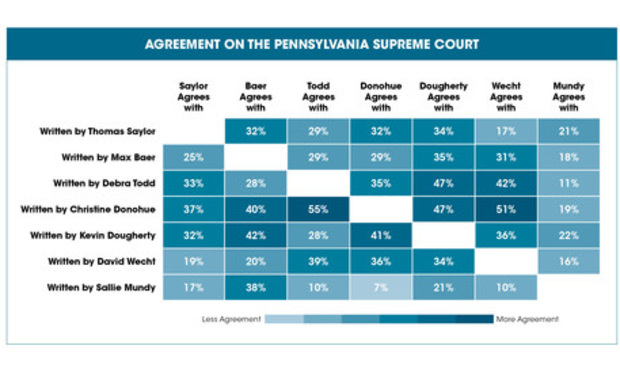 Photo: ALM
Photo: ALM A Law Weekly tally of the Supreme Court of Pennsylvania's work product over the last two years shows that its seven justices like to display an independent streak, and lawyers who looked at the findings stressed that the high court as a whole tends to be unpredictable.
With the election of Sallie Mundy as the court's newest justice, the Supreme Court for the first time in five years enjoys a full complement of commissioned justices. On the eve of what would appear to be an extended period of stability, the Law Weekly looked at court opinions issued between February 2016 and November 2017 to get an insight into the dynamic of the bench.
Justices Christine Donohue, Kevin Dougherty and David Wecht—all elected in 2015—began to drop opinions in February 2016. Mundy came on board as an interim justice in June 2016, in advance of her election.
The court put out 372 opinions dealing with 159 cases during that 22-month period examined by the Law Weekly.
According to court watchers, the data show that the justices in Pennsylvania enjoy writing and are not shy about sharing their opinions. And they expressed nearly uniform surprise at the court's unpredictability.
As Schmidt Kramer attorney Scott Cooper said, ”It shows that they're all independent freethinkers. Even though you may think you know what they're going to do, you're not sure.”
Thought Leaders
Pointing to the sheer volume of their output, court watchers said the two thought leaders on the court appeared to be Chief Justice Thomas G. Saylor and Wecht, while Justice Christine Donohue appeared to be the court's biggest consensus-builder.
From early 2016 until late 2017, Saylor has authored 90 opinions, including 29 majority opinions, with nine of those, or 31 percent, coming in unanimous decisions. Wecht wrote 67 opinions, 28 of which were majority opinions, although only four, or 14 percent, of those opinions were unanimous.
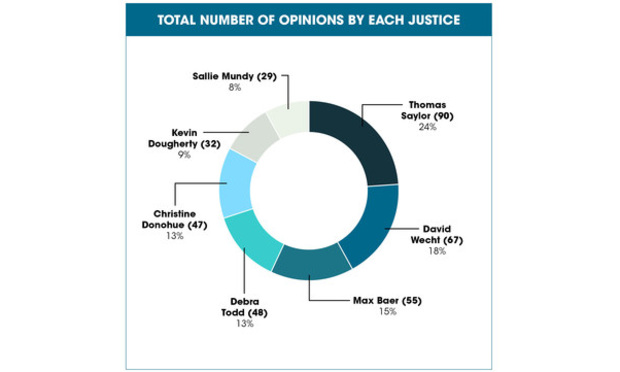 Photo: ALM
Photo: ALM Saylor wrote, by far, the largest number of opinions of any other justice on the court, with 90.
Attorneys said they were not surprised, given his long tenure with the court, his familiarity with the various types of cases that come before the high court, his outspokenness and the expectation that, as chief justice, he take a leading role. Although, given that he also has numerous administrative duties, several court watchers said his level of output was “impressive.”
Court watchers told the Law Weekly they were more surprised by the level of output from Wecht, given that he has only been on the court since 2016.
Although Donohue was in the middle of the pack when it came to her overall output for the 22-month period—writing 47 opinions, including 22 majority opinions, nine of which were unanimous—she had the highest percentage of unanimous opinions, with nearly 41 percent.
Donohue's support came mostly from Justices Debra Todd, who agreed with her 55 percent of the time, and Wecht, who sided with her 51 percent of the time. Justice Kevin Dougherty also agreed with her 47 percent of the time. Those levels of support were the highest three percentages seen on the court.
Donohue also received the highest average level of support from all the justices on the court, earning an average agreement percentage of 41.5 percent.
Appellate attorney Howard J. Bashman said Donohue is a “very talented justice who is very hardworking” and appears to be the justice who can “forge the most consensus” on the court. However, he added that agreement from other justices is not the only indication of consensus, but consensus-builders are also those who can maintain a majority when the court is more fractured on an issue.
“It may be harder to be the one to write the opinion in a 4-3 decision,” he said. “You have to do that in a way that's very sensitive.”
He classified Wecht among the court's consensus-builders.
“To his credit, in cases that may be difficult to hold a majority, his colleagues may view him as someone who has what it takes to hold it together in terms of a majority,” Bashman said.
Dougherty received the second-highest level of agreement from colleagues, with 33.5 percent, and Todd had the third-highest level, with her colleagues join her an average of 32.6 percent of the time.
Mundy garnered the lowest level of support from her colleagues. With only 7 percent support from Donohue, and 10 percent each from Todd and Wecht. Those numbers were the three lowest levels of support seen in the 22-month period.
Mundy garnered an average level of support of 17 percent from her colleagues.
Bashman noted that, while on the Superior Court, Mundy, who served on that intermediate body at the same time as Donohue and Wecht, was thought of as a centrist. He said he wouldn't be surprised to see Mundy, who had been campaigning for a full-term spot on the Supreme Court for much of the time after her appointment, begin voting as more of a centrist in the years to come.
“She comfortably fit on the mainstream of the Superior Court and was not seen as conservative at the time,” Bashman said. ”I wouldn't be surprised if her output went up, and she began voting more as the centrist type of judge she established herself as in the Superior Court.”
Bashman and other court watchers also noted that Mundy's output might be somewhat skewed since she was appointed to the bench several months after Donohue, Dougherty and Wecht took the bench.
Breaking Down Alliances
According to court watchers, the numbers appeared to show Wecht and Mundy as the court's ideological poles, with Justice Max Baer as the most important swing vote.
Cooper said he was surprised at how fluidly the justices share their support among each other.
“I was expecting maybe some were at 70 to 80 percent, but it's only at like 51 and 55 percent. I was surprised,” he added. “I bet if you go back 10 years the numbers were higher.”
One common theme from the attorneys who spoke with the Law Weekly was that the charts show that the justices do not break down on such strong ideological lines as is the case with some other courts, including the U.S. Supreme Court, where some justices agree with each other more than 90 percent of the time.
“The chart makes it clear that there frequently is consensus among court members,” defense attorney Maureen McBride of Lamb McErlane said. “Some may find it surprising, but most would find it encouraging, to see that the court's decisions are not simply divided along ideological lines.”
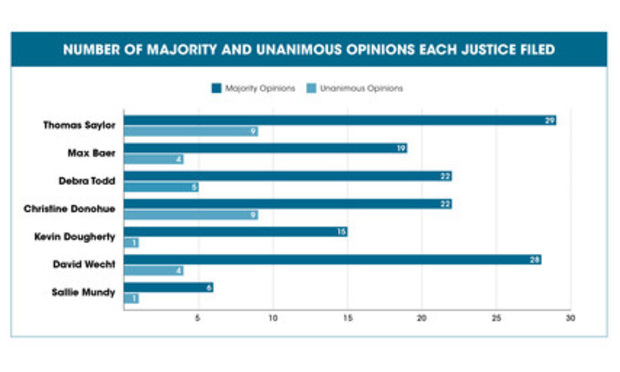 Photo: ALM
Photo: ALM Court watchers did agree, however, that there appears to be a small Democratic block of justices who show higher favorability between each other. That block primarily consists of Donohue, Wecht, Todd and Dougherty.
Regarding Democrat justices, Baer is the biggest outlier. His largest base of support comes from Dougherty, who joined 35 percent of the opinions he wrote. He also typically supported his fellow Democratic colleagues less than others, and provided Mundy with her largest base of support, joining her 38 percent of the time.
When it comes to the two Republicans on the court—Saylor and Mundy—they appear to be much less unified.
Saylor supported Mundy in only 17 percent of the opinions she wrote— supporting her the least out of any other justice—and Mundy agreed with Saylor only 21 percent of the time.
Mundy lent her larger percentage of support to Dougherty, agreeing with him 22 percent of the time.
Two Big Takeaways
Of the 372 opinions the justices filed in that 22-month period, only 141 were majority opinions. That means 229 opinions, or 62 percent of the court's output, does not articulate a precedent for the lower courts to follow.
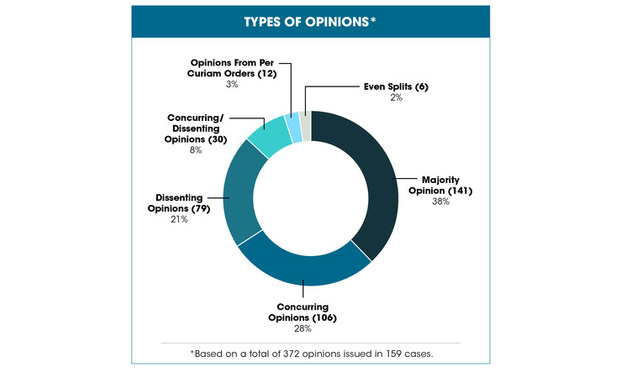 Photo: ALM
Photo: ALM • That number seems high, but practitioners disagreed with the notion that the output created uncertainty for the court.
“There are a lot of times when they are concurring and agreeing with most of the majority opinion, but they're writing something additional,” Cooper said. “It's little offshoots, but the central issue they agree with.”
Bashman also noted that the 141 majority opinions came in 159 cases.
“In 86 percent of the cases the law is pretty clear,” Bashman said. “If people want to write separately, they've earned that right.”
• Saylor has long been seen as a vocal outsider, or, as one court-watcher said, an “iconoclast,” on the court, with dissents and concurrence far outpacing precedential opinions. And his ascension as chief justice did not seem to change that impression among court watchers.
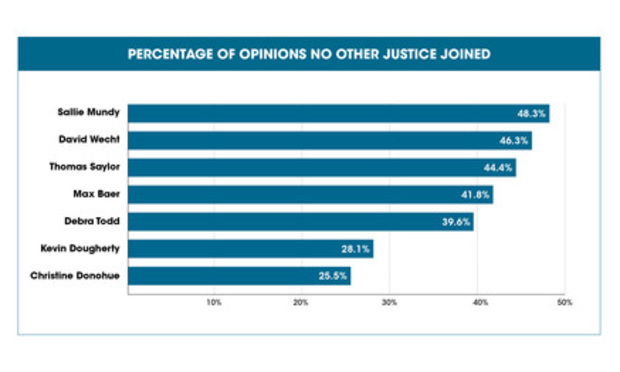 Photo: ALM
Photo: ALM Not only was his total output far greater than every other justice, he also issued a high percentage of opinions that no other justice joined. But, with Mundy issuing nearly 50 percent of her opinions without any support from her colleagues, and Wecht's eye-catching output not far behind her in terms of solo opinions, Saylor is not the only justice seen as a vocal outsider on the court.
According to court watchers, though, with its large output and fluid agreement, Saylor's vocal style as chief justice does not appear to be getting in the way of leading the court.
“Given that there's a 5-2 Democratic majority on the court, there certainly will be cases where Justice Saylor might not find his generally preferred viewpoints winning the day,” Bashman said. ”The degree to which this court will reflect his point of view is something that Pennsylvania's electorate controls.”
This content has been archived. It is available through our partners, LexisNexis® and Bloomberg Law.
To view this content, please continue to their sites.
Not a Lexis Subscriber?
Subscribe Now
Not a Bloomberg Law Subscriber?
Subscribe Now
NOT FOR REPRINT
© 2025 ALM Global, LLC, All Rights Reserved. Request academic re-use from www.copyright.com. All other uses, submit a request to [email protected]. For more information visit Asset & Logo Licensing.
You Might Like
View All

Best Practices for Conducting Workplace Investigations: A Legal and HR Perspective
9 minute read
Plaintiff Argues Jury's $22M Punitive Damages Finding Undermines J&J's Talc Trial Win
4 minute read
Pa. High Court: Concrete Proof Not Needed to Weigh Grounds for Preliminary Injunction Order
4 minute readTrending Stories
- 1Bittensor Hackers, Accused of Stealing Over $28 Million, Face Federal Lawsuit
- 2In Novel Oil and Gas Feud, 5th Circuit Gives Choice of Arbitration Venue
- 3Jury Seated in Glynn County Trial of Ex-Prosecutor Accused of Shielding Ahmaud Arbery's Killers
- 4Ex-Archegos CFO Gets 8-Year Prison Sentence for Fraud Scheme
- 5Judges Split Over Whether Indigent Prisoners Bringing Suit Must Each Pay Filing Fee
Who Got The Work
J. Brugh Lower of Gibbons has entered an appearance for industrial equipment supplier Devco Corporation in a pending trademark infringement lawsuit. The suit, accusing the defendant of selling knock-off Graco products, was filed Dec. 18 in New Jersey District Court by Rivkin Radler on behalf of Graco Inc. and Graco Minnesota. The case, assigned to U.S. District Judge Zahid N. Quraishi, is 3:24-cv-11294, Graco Inc. et al v. Devco Corporation.
Who Got The Work
Rebecca Maller-Stein and Kent A. Yalowitz of Arnold & Porter Kaye Scholer have entered their appearances for Hanaco Venture Capital and its executives, Lior Prosor and David Frankel, in a pending securities lawsuit. The action, filed on Dec. 24 in New York Southern District Court by Zell, Aron & Co. on behalf of Goldeneye Advisors, accuses the defendants of negligently and fraudulently managing the plaintiff's $1 million investment. The case, assigned to U.S. District Judge Vernon S. Broderick, is 1:24-cv-09918, Goldeneye Advisors, LLC v. Hanaco Venture Capital, Ltd. et al.
Who Got The Work
Attorneys from A&O Shearman has stepped in as defense counsel for Toronto-Dominion Bank and other defendants in a pending securities class action. The suit, filed Dec. 11 in New York Southern District Court by Bleichmar Fonti & Auld, accuses the defendants of concealing the bank's 'pervasive' deficiencies in regards to its compliance with the Bank Secrecy Act and the quality of its anti-money laundering controls. The case, assigned to U.S. District Judge Arun Subramanian, is 1:24-cv-09445, Gonzalez v. The Toronto-Dominion Bank et al.
Who Got The Work
Crown Castle International, a Pennsylvania company providing shared communications infrastructure, has turned to Luke D. Wolf of Gordon Rees Scully Mansukhani to fend off a pending breach-of-contract lawsuit. The court action, filed Nov. 25 in Michigan Eastern District Court by Hooper Hathaway PC on behalf of The Town Residences LLC, accuses Crown Castle of failing to transfer approximately $30,000 in utility payments from T-Mobile in breach of a roof-top lease and assignment agreement. The case, assigned to U.S. District Judge Susan K. Declercq, is 2:24-cv-13131, The Town Residences LLC v. T-Mobile US, Inc. et al.
Who Got The Work
Wilfred P. Coronato and Daniel M. Schwartz of McCarter & English have stepped in as defense counsel to Electrolux Home Products Inc. in a pending product liability lawsuit. The court action, filed Nov. 26 in New York Eastern District Court by Poulos Lopiccolo PC and Nagel Rice LLP on behalf of David Stern, alleges that the defendant's refrigerators’ drawers and shelving repeatedly break and fall apart within months after purchase. The case, assigned to U.S. District Judge Joan M. Azrack, is 2:24-cv-08204, Stern v. Electrolux Home Products, Inc.
Featured Firms
Law Offices of Gary Martin Hays & Associates, P.C.
(470) 294-1674
Law Offices of Mark E. Salomone
(857) 444-6468
Smith & Hassler
(713) 739-1250





